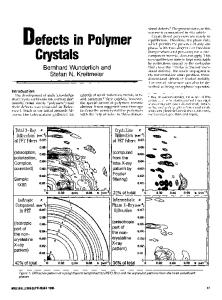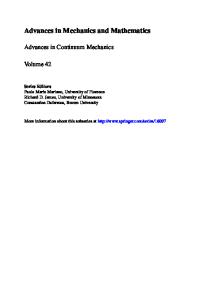Localization of Excitons on Planar Defects in Semiconductor Crystals
- PDF / 284,159 Bytes
- 4 Pages / 612 x 792 pts (letter) Page_size
- 73 Downloads / 437 Views
D MATTER
Localization of Excitons on Planar Defects in Semiconductor Crystals M. M. Mahmoodiana, b, * and A. V. Chaplika, b, ** a
Rzhanov Institute of Semiconductor Physics, Siberian Branch, Russian Academy of Sciences, Novosibirsk, 630090 Russia b Novosibirsk State University, Novosibirsk, 630090 Russia *e-mail: [email protected] **e-mail: [email protected] Received June 18, 2020; revised June 27, 2020; accepted July 10, 2020
Localized states of a large-radius exciton on a planar short-range defect, which is simulated by the potential 2 −V δ(z ), are studied theoretically. The ratio of the amplitude V to e /ε (ε is the dielectric constant) determines two asymptotic regimes of weak and strong localization. In both cases, the radiation lifetime of the exciton increases with V according to power laws V 1/ 4 and V in the cases of weak and strong localization, respectively. DOI: 10.1134/S0021364020160080
The formation of bound states of excitons with various kinds of defects is of considerable interest for the physics of excitons. In the case of charged impurity centers, the interaction of an exciton with a defect is long-range and leads to the formation of an atom-like complex. A typical example is the localization on a charged donor, observed in gallium arsenide quantum wells [1]. The same exciton localization in all three dimensions is implemented on fluctuations of the quantum well thickness [2]. Two-dimensional structural lattice defects lead to one-dimensional localization of the exciton, when the motion of its center of mass along the defect remains free. Such defects can correspond to a short-range potential. Examples are planar stacking faults, twins, and block boundaries. The bound state of the exciton at the twin boundary was studied in [3]. The authors of [3] performed ab initio numerical calculations for GaAs and showed, in particular, that the radiative lifetime of the exciton in the presence of a twin increases. The authors of [4] studied the localization of the exciton on a planar defect of another type, when the built-in electric field is essential. It corresponds to a double layer and, consequently, to a jump in the potential when passing through the plane of the defect. In the model used in [4], the effective stacking fault potential consists of a rectangular barrier and a delta well at its edge. The ground state of a localized exciton is found by a direct variational method, and the hole is assumed to be rigidly localized on the plane of the defect (the localization length is zero). In such an asymmetric system, the
exciton has a large dipole moment along the normal to the plane of the defect [5]. Planar defects with excitons localized on them may be of particular interest for studying collective effects in an exciton gas. A macroscopically correlated phase in an exciton system, which is analogous to a Bose– Einstein condensate, has been studied for a long time (see [6–11]). Experiments are usually carried out with double or wide single quantum wells, in the plane of which electrostatic traps f
Data Loading...







